Google Pixel 7 Review – PhoneArena
Google Pixel 7 Intro
What’s new about the device
- 6.3-inch FHD+ OLED display (vs 6.4-inch on Pixel 6)
- Tensor G2 chipset (vs Tensor G1 on Pixel 6)
- Refreshed design
- New camera features vs Pixel 6
- Improved selfie camera
Table of Contents:
Google Pixel 7 Unboxing
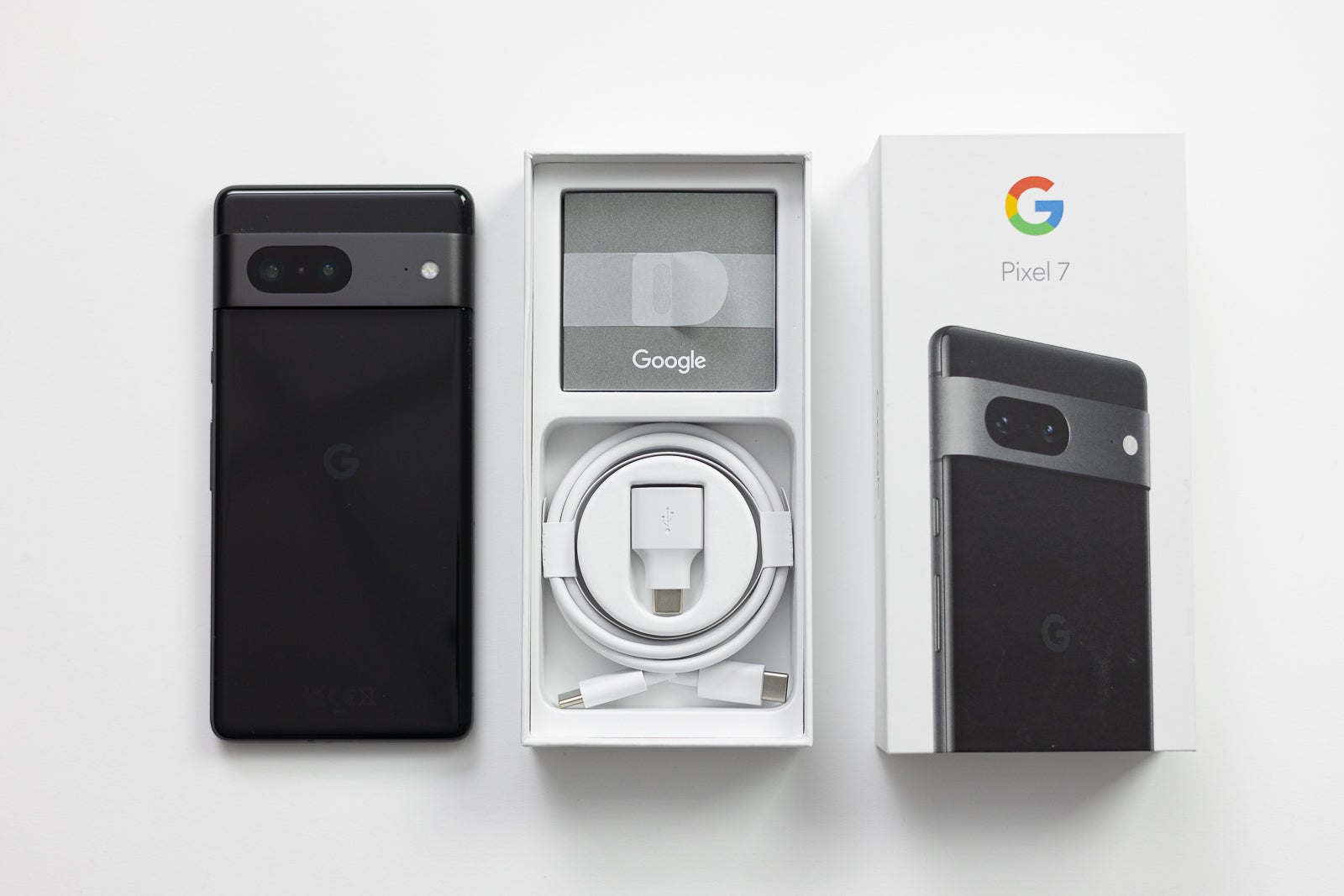
Inside the Google Pixel 7 box, you’ll find the Pixel 7, your usual booklets, a SIM ejector pin, and a USB Type-C cable. You don’t get a wall charger, so you will have to supply one yourself if you don’t have one already. Google recommends using its 30W fast charger, which starts from $25.
Google Pixel 7 Specs
Pixel 6, is that you?
| Specs | Google Pixel 7 | Google Pixel 6 |
|---|---|---|
| Size and Weight | 155.6 x 73.1 x 8.7mm | 158.6 x 74.8 x 8.9mm |
| Display | 6.3″, 1080p, 60-90Hz OLED, flat | 6.4″, 1080p, 60-90Hz OLED, flat |
| Processor | Tensor G2 | Tensor G1 |
| RAM | 8GB | 8GB |
| Storage | 128GB / 256GB, no expandable storage | 128 / 256GB, no expandable storage |
| Software | Android 13 | Android 12/13 |
| Cameras | 50MP wide, f/1.85 12MP ultra-wide, f/2.2 10.8MP front camera |
50MP wide, f/1.9 12MP ultra-wide, f/2.2 8MP front camera |
| Battery Size | 4,355mAh | 4,614mAh |
| Charging Speeds | 30W wired, 20W wireless | 30W wired, 20W wireless |
| Price | $600 (128GB), $700 (256GB) | $600 (128GB), $700 (256GB) |
Google Pixel 7 Models
Aside from the Pixel 7, Google has another Pixel in the lineup, the Pixel 7 Pro, which differentiates itself with an additional camera, larger display and battery, as well as a slew of exclusive software features. Aside from that it’s got the same Pixel 7 DNA. Google was also rumored to be teasing a foldable Pixel during the announcement event, but those expectations did not materialize.
Read more:
Google Pixel 7 Design & Colors
Subtle changes here and there
Building on the design language established by the Pixel 6-series (which we absolutely love), Google addressed the Pixel 7 design in a logical way.
Gone is the dual-tone design of the Pixel 6-series, which had the bottom and top sections of the rear colored in two slightly different color hues. Instead of that, the new Pixel 7 uses a single color for its glass back, separated by a polished aluminum camera bar in a complementary color. The camera bar is no longer black, but proudly shows off the camera cutouts that Google previously tried to hide away. It’s still a pocket lint magnet, though.
And in direct comparison with the Pixel 6, the Pixel 7 not only is a more compact phone—it certainly feels like one. Handling it is a joy, and—surprise, surprise—you can even use it with a single hand! It’s slightly more slippery than what I’d love to see, definitely calling for a protective case to enhance the grip.
The Pixel 7 has Corning’s tough and very scratch-resistant Gorilla Glass Victus both at the front and at the back, which and is also equipped with fingerprint-resistant coating, which helps it retain its pristine looks no matter how long you toy it around. However, the camera strip of our Pixel 7 Pro unit has already started exhibiting some scuffs and scratches at the rear after just a few days of use, which isn’t ideal and doesn’t inspire us with confidence that the same faith wouldn’t befall the Pixel 7 as well.
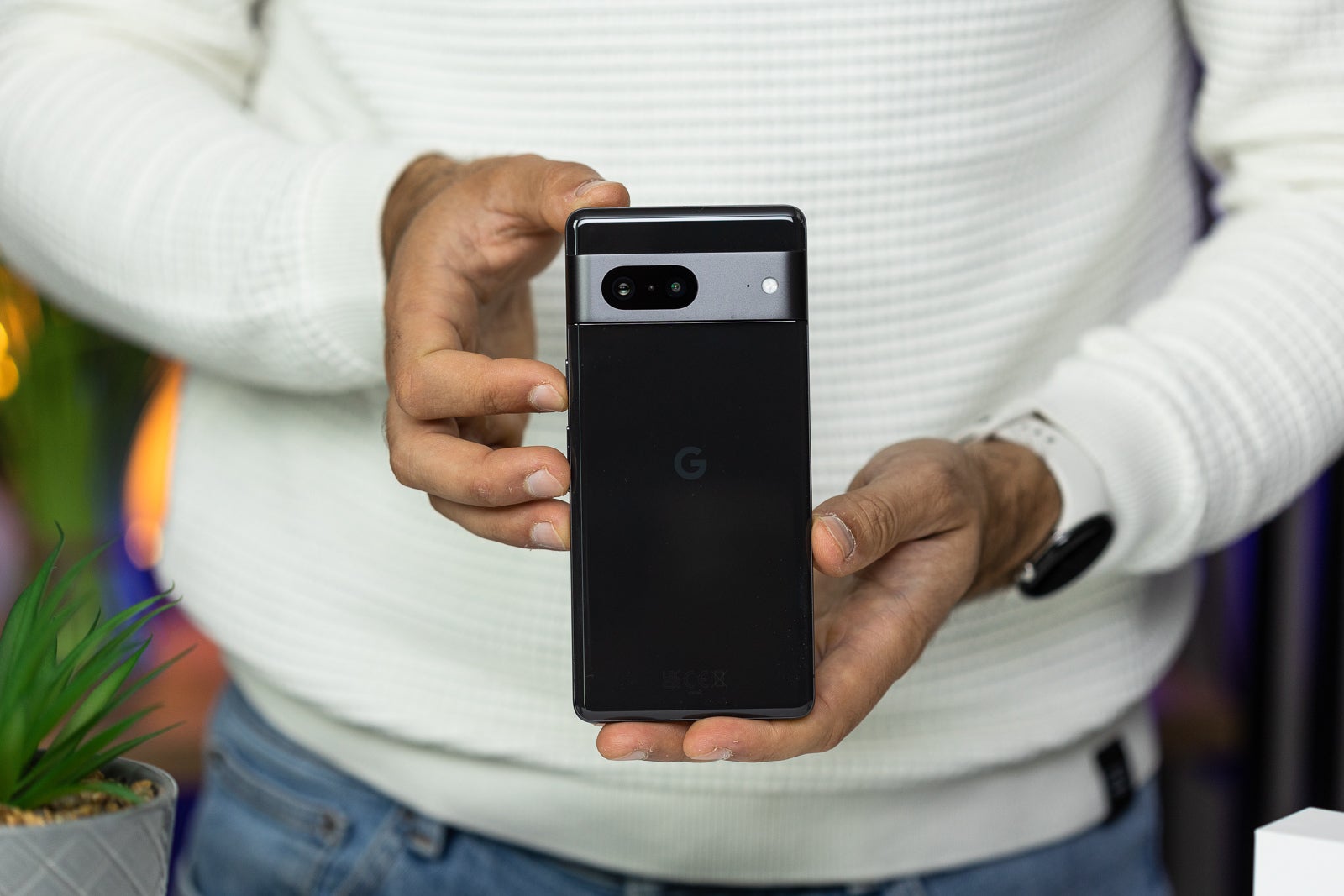
Another important change relates to the overall size of the Pixel 7, especially in comparison with the older Google Pixel 6. The small phone is just a smidgen narrower, thinner, and shorter than its predecessor. This certainly makes it a more compact handset, and it’s safe to say that we are in a dire need of compact phones in the Android space. Yes, these days 6.3 inches almost passes as “compact”. In comparison with another rather popular phone, the iPhone 13, the Pixel 7 is taller and slightly wider, but also thicker and heavier.
The Pixel 7 is equipped with IP68 water and dust protection, and unsurprisingly, lacks a 3.5mm audio jack or a microSD card slot for some additional storage expansion. There’s a single nano SIM card slot, but users can enroll an eligible eSIM, which essentially makes the Pixel 7 a dual-SIM phone.
Despite our hopes that Google would go for Qualcomm’s ultrasonic in-display fingerprint scanners, Google once again relies on an optical under-screen fingerprint scanner, which doesn’t feel much faster than the one used on the Pixel 6 last year. Optical fingerprint scanners require your fingertip to rest a smidgen longer on the display than ultrasonic fingerprint scanners.
You also have to be more accurate with your fingertip placement, as often times a millimeter to the side would cause the phone throw an authentication error and require another attempt. Not such a big of a deal, but at the same time, it is.
In case you don’t want to use the fingerprint scanner (due to one reason or another), there’s also Face Unlock on deck, but you should know that it’s picture-based, so it’s not as secure as Apple’s three-dimensional Face ID.
Google Pixel 7 Display
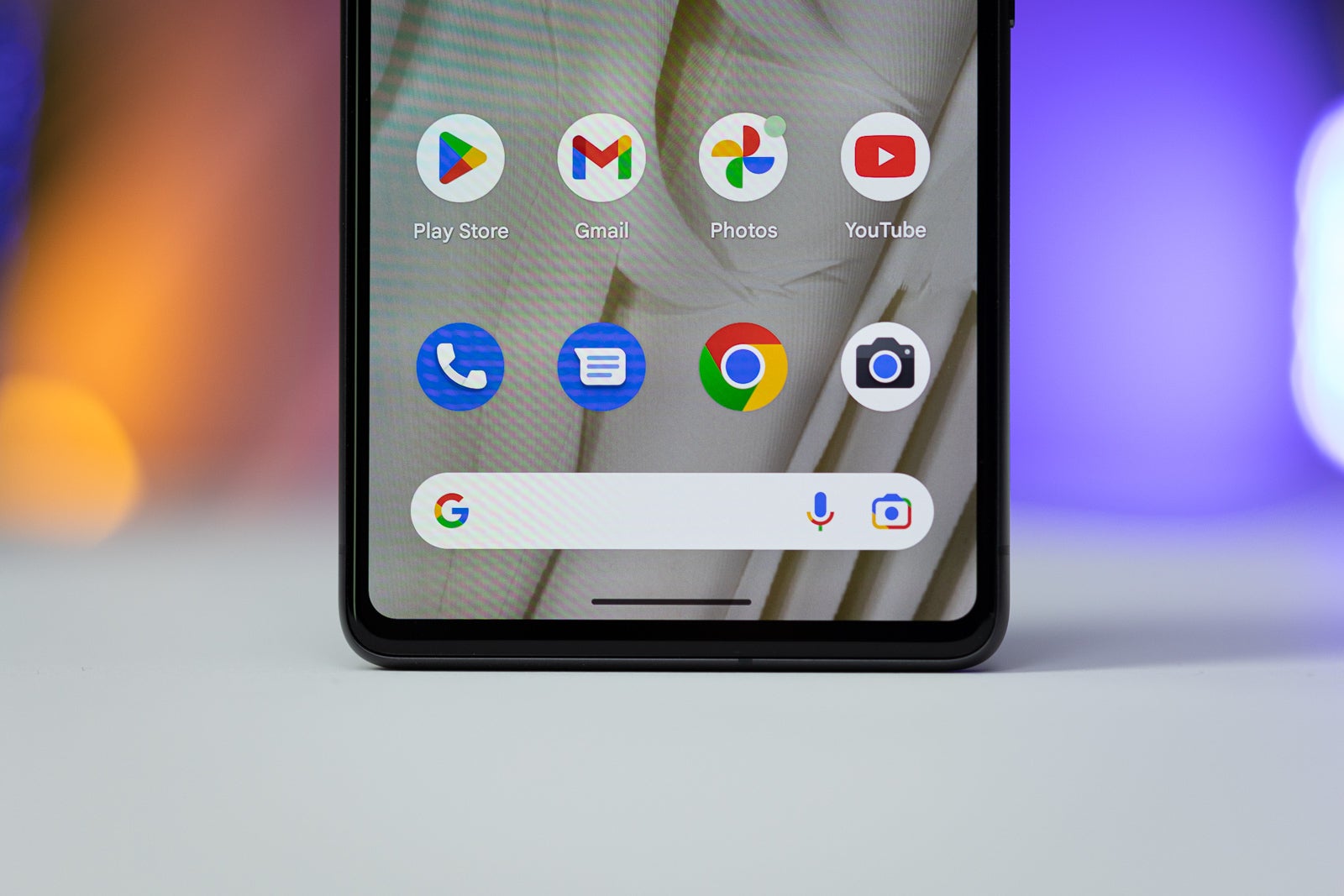
The 6.3-inch OLED display on the Pixel 7 has a resolution of 1080 by 2400 pixels and comes with the same 60 to 90Hz refresh rate as the Pixel 6. The display is completely flat, which is definitely appreciated and everything appears crisp despite the not-so-impressive resolution. The maximum brightness of nearly a 1,000 nits really stands out as one of the key features of the display, but it has a very low minimum brightness as well, making it a good companion for some light reading before bedtime, if that’s up your alley.
Google Pixel 7 Camera
Dual-camera trooper
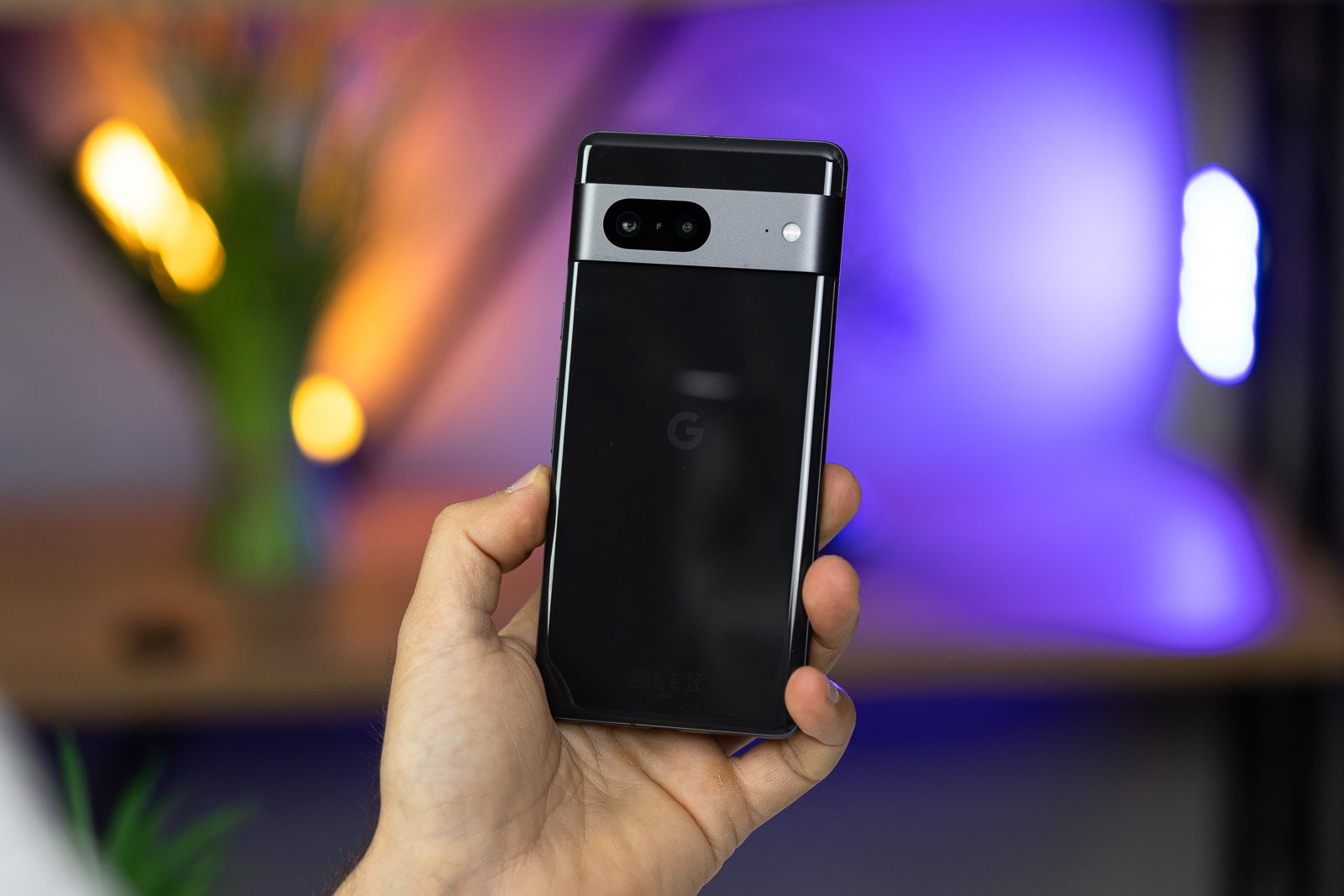
Similarly to the Pixel 6-series, the Google Pixel 7 relies on a dual-camera setup, consisting of a 50MP 1/1.3-inch wide camera with an f/1.85 aperture (an ever-so-slight update over the Pixel 6’s f/1.9) and a ultra-wide 12MP camera that has an f/2.2 aperture, but still a narrower 114-degree field-of-view in comparison with the Pixel 7 Pro and some rivals. At the front, we have an upgraded 10.8MP selfie camera on both the Pixel 7 and Pixel 7 Pro.
- Photo Unblur — Thanks to this feature, the Google Photos app on both new Pixels allows the user to quickly unblur and sharpen an image with just a tap.
- Magic Eraser — This well-known AI-driven software feature gets rid of distractions and photobombers in your images. You can also change the colors and brightness of a subject.
- Real Tone — Google ‘s quest of making its hardware more inclusive has led it to take thousands of pictures of people of color so as to fine-tune the camera and correctly represent non-white skin tones. The new Pixels will recognize a broader set of faces, correctly represent skin color in photos, make skin brightness appear more natural than before, reduce washed-out images, sharpen face even in low light, and provide you with a smarter auto enhance in Google Photos.
- Cinematic Blur — Similar to the iPhone’s Cinematic mode, the new Pixels let you take videos with artificially blurred background while keeping your subjects in focus for that much-coveted dramatic effect.
- Wider front camera — Both devices now have wider 10.8MP selfie cameras with faster f/2.2 aperture.
The camera app is rather feature-rich, but I wouldn’t call it overwhelming. It lays every feature and functionality neatly at your fingertips, and while it takes some snooping around to find all features of the camera app, it’s mostly intuitive.
Another slightly aggravating issue with the camera app is that it takes forever to switch from one sensor to the other and between the various camera modes, despite that we ran the first camera update the second we launched it. If you go through the motions and switch between 0.7X, 1X, and 2X zoom modes, as well as try switching between the video, portrait, camera, Night Sight modes, Pixel 7’s camera app exhibits some noticeable delay. Guess what, an iPhone usually does the same, but the Pixel is a tad slower in this regard.
Finally, I’m not impressed by the finnicky zoom slider, which is on the smaller side and often hard to interact with.
Image Quality
As we mentioned before, the ultra-wide camera is still too narrow for our tastes. Offering a 114-degree field-of-view, it’s just a smidgen wider than the regular wide camera, but the latter is much more capable in any situation, so if possible, I’d usually recommend just stepping back and taking a shot with the regular 50MP shooter. Here’s a quick comparison between the ultra-wide and wide-angle cameras, as well as the default 2X zoom, which crops in from the main camera sensor:
Pixel 7 ultra-wide vs wide-angle camera vs 2X zoom
In broad daylight or when sufficient light is present, the Pixel 7 takes really nice shots, with good detail and great dynamics. The “Pixel look” we’ve come to love over the years, known for its grittier realistic colors and overall feel mixed up with a slightly enhanced contrast, is certainly present on the Pixel 7. We love that. Here are some regular camera samples taken out straight from the Pixel 7, which showcase its forte:
Pixel 7 camera samples
Night or indoor shots with the main camera turn out pretty sharp, and with balanced exposure. The ultrawide, as can be expected, struggles more in these situations, while the selfies are pretty impressive in all situations. There is some noise in most ultra-wide low-light shots, but overall, nothing too out of the ordinary.
Pixel 7 low-light camera samples
The front camera, as we said, is improved, and it now takes really good selfies, with lovely colors and a realistic, gritty tones in certain situations. Portrait shots with the front camera turn out okay, despite the algorithms struggling with subject separation from complex background, which is the usual crux of single-camera portrait modes across the industry.
Pixel 7 selfies
Video quality
The video stabilization, sharpness, and amount of detail are very good, with only the continuous autofocus mode taking a split second to react as opposed to the instantaneous refocusing back and forth we are used to from Samsung phones.
Google Pixel 7 Performance & Benchmarks
The Pixel 7 comes with the Google Tensor G2 chipset on deck, its second-gen custom silicon, which forfeits in the raw synthetic benchmark war for a more user-centric take on things, with features and functionalities geared towards achieving a better user experience. The Tensor’s machine-learning and artificial intelligence capabilities are the highlight of the new chip.
The Tensor G2 uses two performance ARM Cortex-X1 cores, then two mid-range Cortex-A76 cores, and four efficiency Cortex-A55 cores. That said, it’s well behind the Qualcomm, Exynos, and Apple Bionic competition in the synthetic benchmark tests we’ve ran. Despite that, it doesn’t feel slow, or sluggish. The only issue here is that the phone, while really capable in terms of gaming and crunching graphics, gets hot during extended gaming sessions, which negatively affects its battery life. More on that later.
The phone comes with 8GB of LPDDR5 RAM, which should be enough for everyone but the most enthusiastic power users out there. Storage-wise, Google will gladly sell you a 128GB version of the Pixel 7 at the introductory price of $599, as well as a 256GB storage variation for $699.
Google Pixel 7 OS / Android version / Software
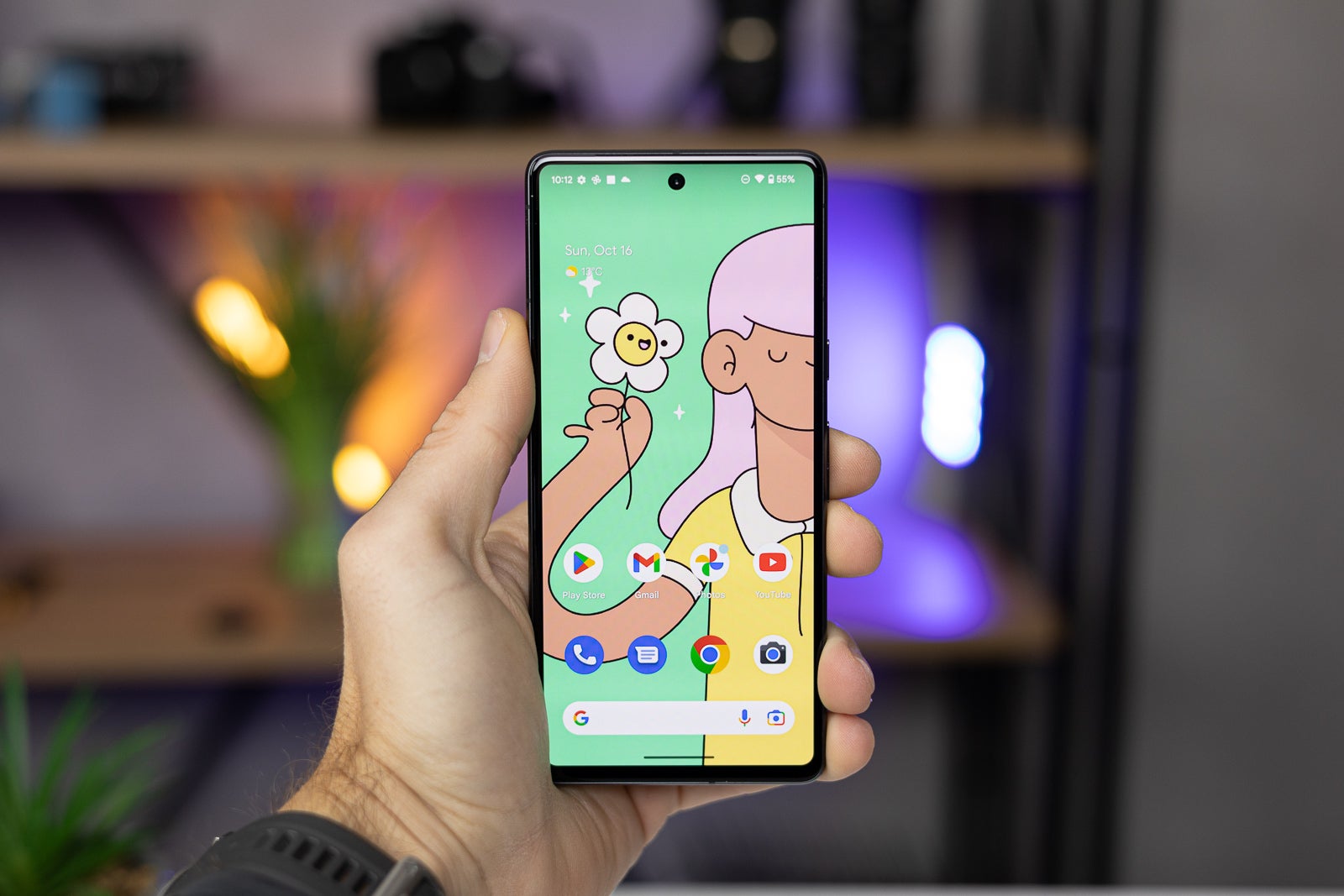
Some notable Pixel-exclusive Android 13 features include, but are not limited to:
- Assistant voice typing will suggest relevant emoji
- Phone can transcribe audio messages in the message app
- Recorder app getting speaker labels
- Pixel Call Assist for phone calls
- Call screen automatically speaks to spammers and filters them out
- Direct My Call for businesses, list of menu options visible right away
- Clear Calling – filters out distracting sounds while enhancing friends voices
In terms of software support, Google promises three years of major software updates and some five years of security patches for the Pixel 7. This means that the Pixel 7 will be graced by Android 16 in 2025 and will still be considered a secure phone by 2027.
This prolonged support really jibes well for regular customers who might be considering the Pixel, but also helps polish Google’s image as well. We are still a good way from the coveted policy promising at least five years of major updates, like Apple’s, but hopefully, in the near future this could change.
Google Pixel 7 Battery
The Pixel 7 comes with a 4,355mAh battery on deck, notably smaller than the Pixel 6’s 4,614mAh unit. On the PhoneArena browsing battery test, which involves automated web surfing and scrolling over a Wi-Fi network at 200 nits of pre-set screen brightness, the Pixel 7 fares comparably to the Pixel 6 and Pixel 6a, two first-gen Tensor devices, but gets dusted by both the Galaxy S22 and the iPhone 14, two very close competitors.
In our video streaming test, the Pixel 7 fared worse than the Pixel 6, scoring a bit over 9 hours. That’s actually better than the Galaxy S22 and iPhone 14, as well as he affordable Pixel 6a by a small margin. This isn’t actually proof that the Pixel 7 has bad battery endurance, on the contrary, it is to show that the Pixel 6 had great battery life!
When it comes to our tasking 3D gaming test, the Pixel 7 failed to impress and scored a much lower score than its predecessor and closest rivals. This goes to show that you probably shouldn’t consider this phone if you’re heavily into gaming, as it wouldn’t provide a very good battery backup. Gaming performance is mostly on point, though.
PhoneArena Battery Test Results:
Good news is that a quick 30-minute rendezvous with the 30W fast charger that Google would sell you for $25 gives the Pixel 7 around 50% of battery charge. This means that one such quick half charge could easily solve any battery woes that you might have with the compact Android device. Charging-wise, there aren’t any big changes—Google advertises 21W fast wired and 21W wireless charging for the Pixel 7, but actually recommends getting the aforementioned 30W fast charger.
Google Pixel 7 Audio Quality and Haptics
With dual stereo speakers on both, the Pixel 7 produces loud and clean but not very “meaty” sound. While that’s not inherently bad, the phone certainly lacks some definition in the base and gives off a more trebly sound. In no way is this an issue, make no mistake!
On the topic of haptics, the Pixel 7 treats us with pleasant haptic feedback that’s definitely not on the strong side. Thankfully, it doesn’t feel muddy, but is rather exact and defined, just not particularly strong four our tastes.
Google Pixel 7 Competitors
The iPhone 14, on the other hand, is the entry-level device in the iPhone 14-series and comes forth with A15 Bionic, dual-camera, and more. It’s the most affordable new iPhone in Apple’s device roster, but is largely similar to the iPhone 13 before it, which made the case for upgrading a rather questionable affair, all things considered.
Read more:
Google Pixel 7 Summary and final verdict
The Pixel 7 is, by all means, an excellent and compact Android phone. What it lacks in terms of performance, it makes up in terms of “smarts” and user experience. It’s a great compact Android phone, a breath of fresh air from your average smartphone that’s pushing 6.7-inches in size.
The Pixel 7 is a no-frills device. It’s the phone you’d recommend to someone who’s not awed by the latest cutting-edge tech and doesn’t really know what a synthetic benchmark is , but would rather have a compact device that looks and feels good, and also offers very good user experience.
Despite a few slight interface issues with the camera and somewhat uninspiring battery life during gaming, the Pixel 7 is a great compact phone that is really enjoyable to use. While the Pixel 7 Pro is definitely a much better phone, with a sharper, larger, and even smoother display, an extra 5X telephoto camera and better battery life, the Pixel 7 is more affordable and basically offers 90% of the same Pixel experience.
With the amount of revisions it exacts on the Pixel 6, the Pixel 7 is a great follow-up to what was already one of the very good phones of 2021. It addresses some key aspects of the Pixel experience and feels like a solid choice that one should definitely shortlist when considering a compact and capable phone in late 2022 and beyond. And with a starting price of $599 for the entry-level version, it’s an excellent deal.


